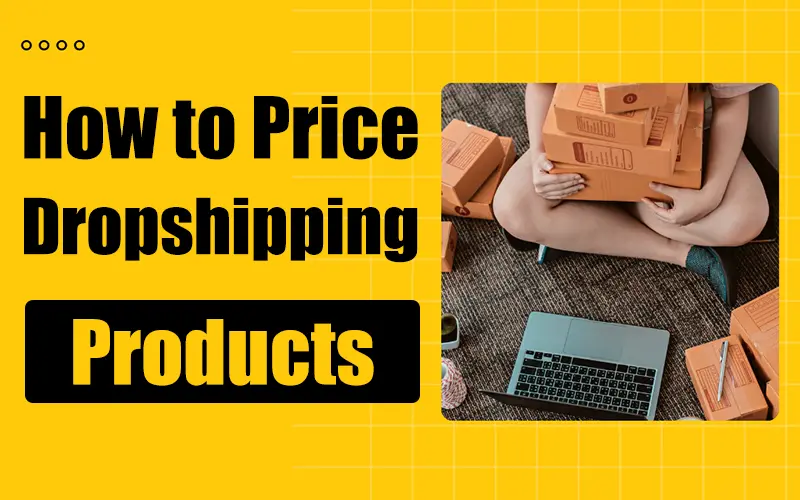Gérer le dropshipping peut être difficile, surtout lorsqu'il s'agit de trouver les bons prix pour vos produits. Dans le blog d'aujourd'hui, nous aborderons la question importante de la tarification efficace des produits en dropshipping. Vous obtiendrez des informations secrètes sur l'identification de la combinaison optimale entre une tarification rentable et des bénéfices solides.
Pour réussir durablement dans le dropshipping, vous devez comprendre l'importance de fixer correctement le prix de vos produits. Poursuivez votre lecture pour savoir comment fixer le prix des produits en dropshipping afin de les rendre plus attrayants pour les clients et d'augmenter vos revenus.

Aperçu de la page:
Qu'est-ce qu'une stratégie de tarification dropshipping ?
Pourquoi avez-vous besoin d’une stratégie de tarification dropshipping ?
Les meilleures stratégies de tarification pour le dropshipping
2. Tarifs d'expédition gratuits et gratuits
5. Tarification basée sur la valeur
7. Tarification à plusieurs niveaux
10. Tarification de pénétration
11. Prix de détail suggéré par le fabricant
Conseils pour fixer le prix des produits de dropshipping
Comment EPROLO vous aide à fixer le prix des produits de dropshipping
Qu'est-ce qu'une stratégie de tarification dropshipping ?
Une stratégie de tarification en dropshipping représente un plan systématique pour identifier les meilleurs prix liés aux produits. Vous devez ajuster soigneusement différents éléments pour augmenter vos revenus tout en gardant une longueur d'avance sur la concurrence.
La stratégie de tarification du dropshipping évalue le coût du produit en fonction des besoins des consommateurs et des prix de la concurrence. Elle prend en compte les dépenses supplémentaires, notamment les frais de livraison et les frais de promotion.
Pourquoi avez-vous besoin d’une stratégie de tarification dropshipping ?
Déterminer comment fixer le prix d'un Le produit dropshipping est vital pour la continuité de votre activité en ligne. Il vous guide à travers le monde complexe du commerce électronique tout en faisant correspondre les besoins des clients à votre modèle commercial. Voici pourquoi il est essentiel de développer une stratégie de tarification solide pour le dropshipping :
- Maximisez les marges bénéficiaires : En créant une stratégie de tarification efficace, vous pouvez reconnaître les fourchettes de prix les plus avantageuses pour vos produits. Pour maximiser les opportunités de profit, vous pouvez évaluer les coûts, les tendances du marché et l'activité des clients. Cette tactique garantit que chaque transaction améliore vos résultats.
- Bénéficiez d'un avantage concurrentiel : Les prix compétitifs jouent un rôle important sur le marché saturé du dropshipping. Une approche tarifaire efficace vous aide à mettre en valeur vos offres de manière plus attrayante que celles de vos concurrents.
- Réduire les risques : Une approche stratégique en matière de prix réduit les risques financiers liés au dropshipping. Faire face aux coûts et aux changements du marché vous aide à éviter les prix bas et les pertes.
Dans l’ensemble, il est impératif de comprendre comment fixer les prix des produits en dropshipping. Un cadre de tarification adaptable permet des ajustements rapides en réponse aux changements des dépenses des fournisseurs ou des facteurs économiques. Cela garantit que votre entreprise reste à l’abri des revers indésirables.
Les meilleures stratégies de tarification pour le dropshipping
Vous vous demandez comment fixer le prix des produits en dropshipping comme un pro ? Voici quelques-unes des meilleures stratégies de tarification en dropshipping à prendre en compte :
1. Marge fixe sur le coût (plus le dollar fixe, plus le pourcentage fixe)
Lorsque vous vendez des produits dropshipping à bas prix, vous pouvez décider d'inclure un montant fixe en dollars ou une marge en pourcentage fixe. Par exemple, cela peut être 5 $ ou 50 %. Cette technique permet d'obtenir une marge bénéficiaire uniforme sur l'ensemble de votre inventaire.
- Facile à comprendre et à mettre en œuvre : Cette stratégie simple facilite le calcul des prix sur l'ensemble de votre gamme de produits.
- Marges bénéficiaires stables : On peut estimer et conserver des bénéfices uniformes pour chaque achat.
- Pouvoir de tarification limité : cette méthode rigide ne tient pas compte de la demande du marché ni de la valeur perçue.
- Risque de surévaluation ou de sous-évaluation : certains produits finissent par être proposés à un prix trop élevé ou trop bas par rapport aux tarifs du marché, ce qui peut affecter les ventes.

2. Tarifs d'expédition gratuits et gratuits
Ce plan consiste à livrer des articles gratuits et les clients ne paient que les frais d'expédition. Les dropshippers l'appliquent généralement aux produits bon marché pour donner l'impression d'une grande valeur. Les frais d'expédition sont souvent fixés pour couvrir à la fois les frais de produits et de manutention, tout en générant un bénéfice.
- Attire l'attention : L'idée de « gratuit » constitue un outil marketing puissant qui peut augmenter considérablement le taux de clics et d'achats.
- Générez des revenus supplémentaires : vous pouvez souvent vente incitative ou vente croisée produits supplémentaires lors du processus de paiement.
- Risque de mauvaise expérience client : les clients peuvent se sentir induits en erreur lorsqu'ils se rendent compte des frais d'expédition élevés, ce qui peut entraîner des avis négatifs ou des demandes de remboursement.
- Faible valeur perçue : Certains clients remettront en question la qualité d'un produit « gratuit ». produit, ce qui pourrait nuire à la réputation de votre marque à long terme.
3. Tarification à coût majoré
La tarification au coût majoré (également appelée tarification basée sur les coûts) est une méthode simple généralement utilisée pour les articles de taille moyenne. Elle consiste à calculer le coût total du produit (y compris l'approvisionnement, l'expédition et les frais généraux) et à ajouter un pourcentage de marge prédéterminé. Par exemple, si un produit coûte 50 $ et que vous définissez une marge de 40 %, le prix de vente sera de 70 $.
- Simple à calculer : Cette méthode est facile à mettre en œuvre sur l'ensemble de votre gamme de produits.
- Bénéfice garanti : Chaque vente garantit une marge bénéficiaire spécifique, assurant la stabilité financière.
- Ignore les conditions du marché : cette stratégie ne prend pas en compte les prix des concurrents ni la demande des clients.
- Marges fixes : vous pourriez manquer des opportunités d'augmenter vos bénéfices sur articles à forte demande.
4. Tarifs des forfaits
La tarification groupée consiste à regrouper plusieurs produits de dropshipping et à les proposer à un prix inférieur à la somme de leurs prix individuels. Cette stratégie fonctionne bien pour les articles de prix moyen, encourageant les clients à acheter davantage tout en percevant une valeur ajoutée.
- Économies perçues : les clients ont le sentiment de faire une bonne affaire. Ce sentiment de valeur peut conduire à une augmentation des ventes.
- Augmente la valeur moyenne des commandes : les offres groupées génèrent généralement des revenus par transaction plus élevés.
- Plus complexe à calculer : Déterminer la bonne composition de forfait et la bonne tarification peut s'avérer difficile.
- Pertes potentielles : Si elles ne sont pas calculées correctement, les offres groupées peuvent réduire la rentabilité globale.
5. Tarification basée sur la valeur
Cette stratégie, idéale pour produits dropshipping à prix élevé, fixe les prix en fonction de la valeur perçue par le client plutôt que du coût. Cela nécessite de comprendre les besoins, les préférences et la volonté de payer de votre marché cible.
- Forte fidélité des clients : lorsque les clients perçoivent une valeur élevée, ils sont plus susceptibles de devenir des acheteurs réguliers.
- Valeur perçue plus élevée : cette stratégie peut positionner vos produits comme des offres haut de gamme et vous aider à vendre vos produits plus efficacement.
- Risque de surfacturation : Une mauvaise évaluation de la perception des clients peut conduire à des prix trop élevés pour le marché.
- Base de clientèle limitée : des prix plus élevés peuvent exclure les acheteurs soucieux de leur budget, réduisant potentiellement votre part de marché globale.

6. Prix compétitifs
La tarification compétitive consiste à suivre les prix des concurrents et à fixer votre prix de vente en fonction des tendances du marché. Cette stratégie nécessite une surveillance constante du marché et des ajustements de prix pour rester compétitif.
- Restez pertinent sur le marché : vous restez compétitif et attrayant pour les clients soucieux des prix.
- Facile à mettre en œuvre : Il est simple de rechercher les prix des concurrents et d'ajuster les vôtres en conséquence.
- Mener à des guerres de prix : une sous-cotation constante peut entraîner des réductions de prix non durables sur l'ensemble du marché.
- Ignore la différenciation des produits : cette stratégie ne tient pas compte des caractéristiques uniques ou des différences de qualité de vos produits de dropshipping.
7. Tarification à plusieurs niveaux
La tarification par paliers permet de définir différents niveaux de prix en fonction des fonctionnalités du produit, de la quantité ou des segments de clientèle. Par exemple, vous pouvez proposer des versions de base, premium et de luxe d'un produit à différents niveaux de prix.
- S'adresse à différents segments de clientèle : cette stratégie répond à différents niveaux de budget et besoins.
- Encourage les achats en gros : cela peut inciter les clients à acheter de plus grandes quantités à de meilleurs tarifs.
- Dérouter les clients : de multiples options peuvent parfois submerger les acheteurs, entraînant une paralysie décisionnelle.
- Complexe à gérer : cette stratégie de tarification nécessite une planification et une gestion minutieuses des différents niveaux de produits et de prix.
8. Tarification dynamique
Dans cette approche, vous ajustez les prix en temps réel. Les changements sont généralement basés sur des facteurs tels que la demande, les conditions du marché et les prix des concurrents. Ces facteurs sont essentiels pour évaluer le prix des articles en dropshipping. Et cette stratégie est souvent utilisée dans les secteurs où la demande ou les coûts fluctuent.
- Maximise les profits : Cette approche vous permet de capitaliser sur les périodes de forte demande et de vous ajuster pendant les périodes plus lentes.
- Flexibilité : Vous pouvez rapidement vous adapter aux changements du marché et aux actions des concurrents.
- Ajoutez de la complexité à votre stratégie de tarification : Cette stratégie nécessite des outils sophistiqués et une surveillance constante.
- Insatisfaction des clients : Les changements de prix fréquents peuvent dérouter ou frustrer certains clients.

9. Tarification psychologique
La tarification psychologique fait appel à la psyché humaine pour s'assurer que les prix paraissent plus attractifs aux yeux des clients. Les tactiques courantes consistent à fixer des prix juste en dessous des nombres ronds (par exemple 9,99 $ au lieu de 10 $) ou à utiliser des prix de charme (par exemple 9,95 $ au lieu de 10 $).
- Augmentation des achats : cette tactique peut conduire à une valeur perçue plus élevée et à davantage d'achats impulsifs.
- Facile à mettre en œuvre : Il est simple à appliquer sur l'ensemble de votre gamme de produits.
- Impact limité à long terme : les clients avertis peuvent devenir insensibles à ces tactiques au fil du temps.
- Cela ne fonctionne pas dans tous les segments : Les marchés du haut de gamme ou du luxe préfèrent les chiffres ronds pour la qualité perçue.
10. Tarification de pénétration
La tarification de pénétration est une stratégie dans laquelle les produits de dropshipping sont initialement proposés à un prix très bas pour gagner rapidement des parts de marché. Une fois que le produit gagne en popularité et établit une clientèle, le prix est progressivement augmenté. Cette approche est particulièrement efficace pour les nouveaux entrants sur des marchés concurrentiels.
- Démarquez-vous de vos concurrents : des prix initiaux bas peuvent attirer l'attention et détourner les clients des marques établies.
- Construisez plus rapidement des parts de marché : une adoption rapide peut conduire à une pénétration plus rapide du marché et à une reconnaissance de la marque.
- Pertes financières initiales : Les prix bas se traduisent par des marges bénéficiaires faibles, voire négatives, au début.
- Difficile d'augmenter les prix : les clients habitués aux prix bas pourraient résister aux augmentations de prix, ce qui pourrait entraîner une perte de ventes.
11. Prix de détail suggéré par le fabricant
Cette stratégie de tarification consiste pour les détaillants à fixer leurs prix en fonction des recommandations du fabricant. Cette approche est courante dans le dropshipping, en particulier lorsqu'il s'agit de dropshipping de marque.
- Tarification cohérente : cette méthode permet de maintenir la cohérence des prix entre les différents détaillants, réduisant ainsi potentiellement guerre des prix.
- Simplifie les décisions de tarification : les détaillants peuvent s'appuyer sur l'expertise du fabricant pour fixer les prix du marché appropriés.
- Flexibilité limitée : cette stratégie limite la capacité d'ajuster les prix en fonction des conditions du marché local ou de la concurrence.
- Risque de surévaluation : si le PDSF est trop élevé pour le marché, cela pourrait réduire les ventes et la compétitivité.
12. Réductions
Les remises désignent une baisse temporaire du prix des produits. Elles peuvent être appliquées de différentes manières, par exemple les soldes saisonnières des fêtes, les remises sur volume ou les offres promotionnelles.
- Stimule les ventes à court terme : les remises peuvent créer une urgence et conduire à des décisions d'achat immédiates.
- Effacer l'inventaire : est utile pour déplacer rapidement les stocks à vente lente ou obsolètes.
- Marges bénéficiaires plus faibles : La baisse des prix a un impact direct sur la rentabilité par unité vendue.
- Dépendance du client : Des remises fréquentes peuvent amener les clients à attendre les soldes, ce qui peut nuire aux ventes au prix fort.
Conseils pour fixer le prix des produits de dropshipping
Maintenant que vous savez comment fixer le prix des produits en dropshipping, examinons quelques conseils supplémentaires pour un profit maximal :
Effectuer une analyse de la concurrence
Créer une solide vue d'ensemble de la concurrence est important pour gérer les prix en dropshipping. Au début, définissez vos principaux concurrents et analysez leurs méthodes de tarification. Vérifiez leur ligne de prix et catégories de produits tout en notant leurs programmes publicitaires.
De plus, observez la manière dont ils se présentent sur le marché : sont-ils axés sur le prix ou sur le luxe ? En analysant ces données, vous pouvez comprendre l'environnement concurrentiel et détecter une approche tarifaire adaptée.
Recherchez votre public cible
Lors de l'élaboration de votre méthode de tarification, concentrez-vous sur les tranches d'âge et les niveaux de revenus. Étudiez votre marché pour savoir comment vos clients potentiels choisissent et ce qu'ils apprécient.
De plus, l’analyse des commentaires des clients et des informations sur les réseaux sociaux révélera dans quelle mesure votre public cible est prêt à investir dans vos offres.

Tenir compte des coûts
Un calcul précis des coûts est essentiel pour une tarification rentable. Tenez compte de toutes les dépenses associées à votre activité de dropshipping :
- Coût du produit : Le coût du produit que vous payez au fournisseur dropshipping pour chaque article.
- Frais d'expédition : incluez à la fois le coût que vous payez au fournisseur et ce que vous facturez aux clients.
- Coûts de marketing : budget pour la publicité, la création de contenu et d'autres activités promotionnelles.
- Retours : Tenez compte du coût potentiel des retours et des remboursements.
- Marges bénéficiaires : Déterminez la marge bénéficiaire souhaitée pour chaque produit ou catégorie.
Assurez-vous que vos prix couvrent tous ces coûts tout en restant compétitifs sur le marché.
Expérimentez et ajustez votre prix
Il est essentiel de déterminer comment fixer le prix des produits en dropshipping de manière rentable. Analysez régulièrement vos gammes de prix et utilisez les tests A/B pour vérifier comment les différents niveaux de prix influencent le taux de conversion.
De plus, soyez prêt à modifier votre approche tarifaire en fonction de la saisonnalité ou des changements dans les préférences de vos clients. N'oubliez pas que dans le domaine actuel des achats en ligne, qui évolue rapidement, l'adaptabilité est très importante !
Offrir un service de marque
Créez une présence de marque solide qui correspond au public cible. Ce service peut prendre en charge des coûts élevés et renforcer les liens avec les clients. Explorez l'idée de créer des packages personnalisés et la livraison d’ensembles de produits uniques.
En vous concentrant sur l’amélioration de vos offres, vous pouvez non seulement exiger de meilleurs prix, mais également réduire la sensibilité des clients aux prix.
Comment EPROLO vous aide à fixer le prix des produits de dropshipping
Fixation automatisée des prix de dropshipping : EPROLO propose une vaste collection de outils automatisés. Ces outils peuvent simplifier et améliorer votre approche de tarification en dropshipping.
Règles de tarification ajustables : Grâce à la flexibilité de ces règles de tarification, vous pouvez créer des calculs automatiques spécifiques à vos objectifs commerciaux. Vous pouvez également maintenir la cohérence et l'efficacité des méthodes de tarification.
Application pour importer des listes : Un autre atout majeur d'EPROLO est sa prise en charge des listes d'importation. La gestion d'inventaires étendus devient plus facile et plus rapide à mesure que les listes d'importation réduisent les demandes de temps et d'efforts.
Surveillance facile des prix : De plus, le tableau de bord d'EPROLO permet une visualisation claire des prix. Vous pouvez ainsi facilement évaluer et vérifier les prix fixés pour comprendre votre approche tarifaire en un coup d'œil.

Avec des outils automatisés et des interfaces claires, EPROLO devient essentiel pour les dropshippers. Il les aide à améliorer leurs stratégies de tarification et à défier leurs concurrents sur le marché du commerce électronique.
Conclusion
La tarification correcte d'un produit de dropshipping est importante pour le succès et la compétitivité de votre entreprise. La tarification correcte augmente vos profits et établit la confiance avec vos acheteurs. Elle favorise à son tour un succès durable. Lorsque vous envisagez de fixer le prix d'un produit de dropshipping, l'approche de prix optimale fait référence à vos coûts et au public que vous ciblez.
En outre, examinez vos concurrents pour savoir comment fixer les prix des produits en dropshipping. Réfléchissez à la manière dont vous souhaitez présenter votre marque : abordable ou plus luxueuse. Enfin, à mesure que la dynamique du marché évolue, continuez à ajuster les prix pour garantir la rentabilité de votre entreprise et trouver un écho auprès de vos clients.
FAQ
Quelle stratégie de tarification en dropshipping est la meilleure ?
Les stratégies telles que la tarification basée sur la valeur (tarification basée sur la perception du client) sont courantes. Cependant, il n'existe pas de modèle de tarification uniforme. Votre niche et vos concurrents, ainsi que votre public, déterminent la stratégie la plus efficace.
Dois-je utiliser une tarification fixe ou dynamique en dropshipping ?
Avec une tarification fixe, vos coûts sont simples et fiables, tandis que la tarification dynamique évolue en fonction des préférences des clients et de la concurrence. La tarification dynamique offre un potentiel de profit plus important, mais nécessite une attention et des changements continus.
La tarification psychologique peut-elle faire la différence en dropshipping ?
Oui, par exemple, l'utilisation de prix se terminant par 0,99 ou 0,95 peut créer un sentiment de valeur et améliorer les opportunités de vente. Cela permet de se connecter aux habitudes d'achat et d'augmenter les chances de vente.
Comment m’assurer que la stratégie de prix que je choisis ne dévalorise pas ma marque ?
Évitez de sous-évaluer vos produits juste pour rester compétitif. Concentrez-vous plutôt sur la création de valeur par la qualité, le service client et l'image de marque. Les prix doivent refléter la valeur de vos offres, et pas seulement leur coût.
Quelle est une bonne marge bénéficiaire pour le dropshipping ?
Les marges bénéficiaires du dropshipping varient mais se situent généralement entre 15 % et 20 %, selon la niche et les coûts du produit.
Comment calculer les bonnes marges bénéficiaires pour les produits dropshipping ?
Pour calculer les marges bénéficiaires appropriées pour les produits dropshipping, vous devez déterminer la différence entre votre prix de vente et vos coûts totaux.
Utilisez la formule suivante : Bénéfice brut = Revenus moins (COGS + autres dépenses)
Le chiffre d'affaires correspond au prix de vente du produit et le coût des marchandises vendues correspond au prix que vous payez à votre fournisseur pour le produit. Les autres dépenses comprennent les frais d'expédition, les frais de transaction, les frais de marketing, etc.
Une fois que vous avez le bénéfice brut, vous pouvez calculer la marge bénéficiaire en utilisant :
Marge bénéficiaire = (Bénéfice brut ÷ Chiffre d'affaires) × 100








